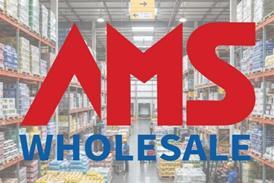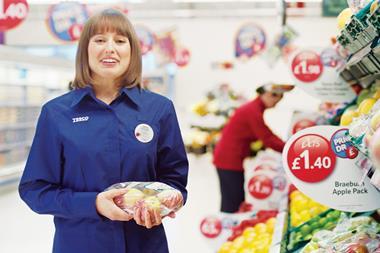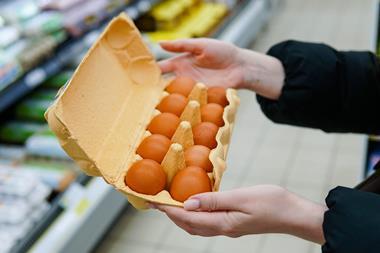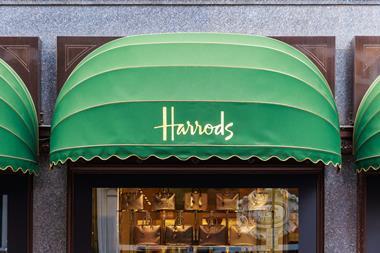Water margin: price is the crucial issue
As the premium branded water market grows, will price become the major factor? Sue Barnard reports
I'll stock purified water as soon as it becomes as cheap as own-label lemonade." Such words these were spoken by a multiple buyer speaking at a recent soft drinks conference are giving branded premium water producers sleepless nights.
It's a sensitive issue and a volatile market, with a plethora of brands queuing up to gain space on the supermarket shelves. As a consequence, some branded producers are only prepared to comment off the record.
One supplier says: "Purified waters are big in the States. They are available in the UK, but are not being stocked to any great extent because the price is not low enough. But the time could come when they make an impact. Retailers have already driven down the price of spring water to around 20p a litre. If the price drops to the same level as own-label lemonade it will do no end of damage. It's becoming a commodity market.
"The supermarkets are squeezing every penny out of the brands. They are looking for 40-50% profit on return. Compare that to wine and beer at 30-35%. They see water as a cash cow and are not looking to build the category."
Others are not so convinced, however. Nikita Droin, managing director of Perrier Vittel UK, says: "If the market becomes commoditised, its growth will be reduced. There will always be some people who will buy the cheapest on display products, but there is a need to satisfy the differing needs of other consumers, including social, functional and health needs.
"Many consumers are looking for quality and consistency from premium brands and are willing to pay for this added value. The market is in 25% growth. This is not being driven by commodity purchasing.
"I have no major concern that this will become a commodity market so long as there is no complacency and the brand owners and drivers continue to invest above the line to communicate their brand propositions."
Suzanne Casey, trade marketing manager for Highland Spring, feels low-priced products have a role to play, but for those who do not buy water, price is not the issue. She says: "Reaching these consumers is the challenge for retailers and producers."
Another insider is critical of the retailers' selection of premium lines. He says: "Supermarkets are letting the French take control of the sector. Typically, they have six to eight French brands. We have to ask ourselves how many French waters we need. All that happens is that they promote against each other and drive down the price. A wider choice of countries brings a point of difference into the market and allows the sector to maintain its margins."
But Droin, who supplies the Perrier, Vittel and Buxton brands, defends his company's position. He says: "The choice is determined by consumers and what they purchase. When Perrier arrived 20 years ago, the market was almost non-existent. Foreign brands have grown because their producers have developed the market and consumers recognise these brands.
"Foreign brands were much more dominant 20 years ago, but domestic brands have increased significantly. The market has grown strongly in recent years; we have all benefited."
With a dearth of products on the market, producers are increasingly hungry for new ways of differentiating their brands to avoid the me-too trap. Last year, Zenith ran a whole conference on the theme of "Selling the Difference".
Zenith chairman Richard Hall says: "Differentiation is one of the biggest concerns producers face and they must keep doing more in an increasingly challenging marketplace. This must start with educating the consumer about the differences between the water types and their attributes. It's a problem the wine industry has had to face and it has been successful."
Hall also believes that brands could put more emphasis on the differences in content. Chiltern Hills, for example, highlights its calcium content, while others emphasise their low sodium content, their heritage or their purity.
Hall says: "There are still a lot of things that can be done to gain marketing edge, in addition to packaging, labelling, size and availability."
Having three retail brands could pose the problem of duplication, but Perrier Vittel UK's investment in the market has been geared towards developing a clear niche for each range. Each brand has different packaging, product size and marketing message depending on its target group. Buxton is the family water, which means it leans towards bulk purchasing with its five-litre pack size and multipacks, while brand sponsorship focuses on cancer research and sport for children.
Vittel is designed for the impulse purchase and sways towards the health conscious. Its packs come in 1.5 litre and 50cl sizes, in addition to a pack containing a sports drinking cap. Health and the French origin are the main focus of the branding. Marketing includes sponsorship of the Vittel Fitness challenge and the brand is the official mineral water for the Flora London Marathon.
Perrier targets celebratory and social events. Its glass packaging is aimed at providing a sophisticated look for its loyal customers, while the brand has a strong presence at the Wimbledon Lawn Tennis Championships, Henley and Ascot.
The Ballygowan range of mineral waters, meanwhile, focuses on its Irish roots while incorporating a health and fun message. Its target audience in the UK includes the Irish population, the younger market which it communicates with through its work with the National Union of Students and consumers up to 35 years of age.
Chiltern Hills is currently developing a point of difference by working in partnership with an electrical appliance producer to create the Eddy watercooler, which delivers chilled Chiltern Hills mineral water for home use. Chiltern Hills has launched a six-litre retail PET bottle especially for the watercooler.
Managing director David Kearns says: "Where watercoolers are provided within the work environment, mineral water quickly becomes an automatic everyday choice. Medical experts are increasingly telling consumers that a healthy diet should include at least two litres of mineral water a day. This suddenly becomes much easier to achieve with a watercooler, which gives a strong reason for introducing watercoolers into the home market.
"The move is part of our long-term strategy to drive a real point of difference within the market."
Other producers have looked at packaging to excel their points of difference. Packaging design is one of Ty Nant's strengths, for which it has won several awards. Director Nick Taylor says: "We have taken the sophisticated route with our bottle, not pretty pictures of waterfalls and streams. When the product was launched we emphasised its originality, but this has since been dropped in favour of its Welsh origins."
Although this product is a natural mineral water it is marketed as a spring water. Taylor says: "The term spring' is easier for consumers to understand, but it could be time for us to move to a natural' labelling because of the threat of inferior products coming in."
Zenith's Hall believes quality and price will remain vital issues. As everyday bottled water consumption grows, he says, price will become an increasingly important factor and the industry will have to work hard at keeping production costs down while improving efficiencies and promoting the products' attributes.
Casey believes multipacks and products for the impulse sector, such as 500ml PET and sports cap products, will fuel growth, but that all bottled water types will grow over the next five years, driven by a wider understanding of products' underlying health benefits, particularly among the younger age groups.
Spadel sales and marketing manager Chris Garbett also agrees that packaging innovation will fuel the market, but stresses that the industry is not doing too badly so far. "Bottled water exceeded one billion litres in the UK for the first time in 1999," he says. "The industry must be getting something right."
But although differentiation and maintaining the strength of the brand are major components of the marketing mix, other elements must not be overlooked, according to Market Assessment International. One major problem the industry faces is stock management or mismanagement. The company feels that a reduction in out of stocks and improvements in weather forecasting could add as much as 2-3% to soft drink sales between 2000 and 2005.
In its report Bottled Waters 2000, MAI argues that ensuring the whole shelf space offers the most profitable combinations will be vital in future, with leading grocery multiples needing to pay more attention to the issue of out of stocks and suppliers anticipating the situation more effectively.
{{FOCUS SPECIALS }}
Close menu
- Home
- Retail & Wholesale
-
Products & Suppliers
- Back to parent navigation item
- Products & Suppliers
-
Product Categories:
- Back to parent navigation item
- Product Categories:
- Alcoholic drinks
- Bakery
- Cereals & breakfast
- Cheese
- Chicken & poultry
- Chocolate
- Confectionery
- Crisps, nuts & snacks
- Dairy
- Fish
- Fresh produce
- Frozen
- Household
- Meat
- Own Label
- Sauces & condiments
- Seasonal
- Soft drinks
- Vaping
- Vegan & plant-based
- World foods
- Suppliers
- People
- Reports & Data
-
Topics A-Z
- Back to parent navigation item
- Topics A-Z
-
Popular topics:
- Back to parent navigation item
- Popular topics:
- Cost of living crisis
- Crime
- Deposit Return Schemes
- Finance
- Government & Regulation
- Health
- Inflation
- Loyalty
- Marketing
- Mergers & Acquisitions
- New Product Development
- Sourcing
- Supply chain
- Sustainability & environment
- Technology
- Ultra Processed Foods
- Vaping
- A-Z all topics
- Content by type:
- Events
- Ask iA (beta)
- Subscribe now
Sign in to comment on this article
Not logged in before? Register for FREE guest access today.
You will be able to:
- Read more stories
- Receive daily newsletters
- Comment on stories
Advert
















No comments yet